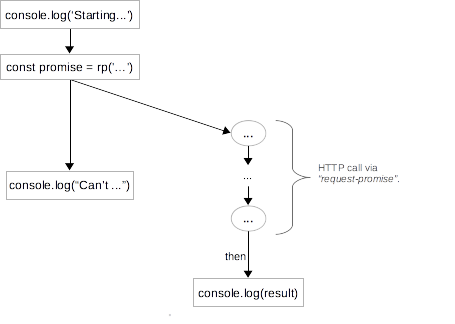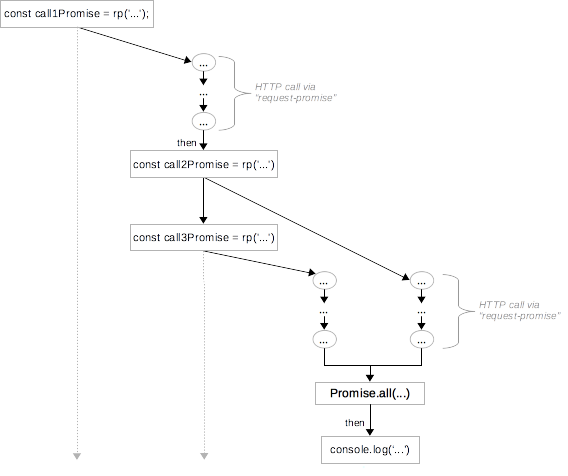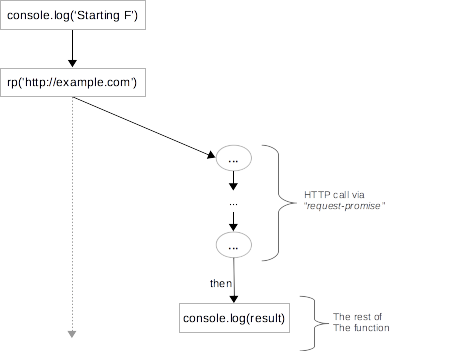Table of Contents
- Introduction
- Promises
- The Problem - Composing Promises
- Async Functions
- Await
- Error Handling
- Discussion
Introduction
The async/await
syntax in JavaScript ES7 makes it easier to coordinate asynchronous promises.
If you need to asynchronously fetch data from multiple databases or APIs in a
certain order, you can end up with a spaghetti of promises and callbacks.
The async/await construct allows us to express such logic more succinctly
with more readable and maintainable code.
This tutorial explains JavaScript async/await syntax and semantics with diagrams and simple examples.
Before we dive in, let’s start with a brief overview of promises. Feel free to skip this section if you already know about JS promises.
Promises
In JavaScript, a promise represents an abstraction of non-blocking asynchronous execution.
JS promises are similar to Java’s Future or
C#’s Task,
if you have come across them.
Promises are typically used for network and I/O operations - e.g. reading from a file, or
making HTTP requests. Instead of blocking the current “thread” of execution, we can spawn
an asynchronous promise, and use the then method to attach a
callback which will be triggered when the promise completes. The callback itself can return
a promise, and thus we can effectively chain promises.
For the sake of simplicity, in all examples we’ll assume that the request-promise library has been installed and loaded as:
1
const rp = require('request-promise');
Now we can make a simple HTTP GET request that returns a promise as
1
const promise = rp('http://example.com/')
Now, let’s look at an example:
1
2
3
4
5
6
console.log('Starting Execution');
const promise = rp('http://example.com/');
promise.then(result => console.log(result));
console.log("Can't know if promise has finished yet...");
We spawned a new Promise on line 3, and then attach
a callback function to it on line 4. The promise is asynchronous, so when
we reach line 6, we can’t know if the promise has completed or not.
If we run the code multiple times, we may get different results each time.
More generally, the code after any promise is spawned runs concurrently with the promise.
There is no reasonable way to block the current sequence of operations until promise has finished.
This is different from Java’s Future.get,
which allows us to block the current thread until a Future has completed.
In JavaScript, we can’t easily wait for a promise. The only way to schedule code after promise,
is to attach a callback via then.
The following diagram depicts the computational process of the example:

The callback attached via then executes only if the promise is successful.
If it fails (e.g. due to a network error), the callback will not execute.
To handle failed promises, you can attach another callback via catch:
1
2
3
rp('http://example.com/').
then(() => console.log('Success')).
catch(e => console.log(`Failed: ${e}`))
Finally, for test purposes we can easily create “dummy” promises that succeed or fail
with the Promise.resolve and Promise.reject methods:
1
2
3
4
5
6
7
8
9
10
11
12
const success = Promise.resolve('Resolved');
// Will print "Successful result: Resolved"
success.
then(result => console.log(`Successful result: ${result}`)).
catch(e => console.log(`Failed with: ${e}`))
const fail = Promise.reject('Err');
// Will print "Failed with: Err"
fail.
then(result => console.log(`Successful result: ${result}`)).
catch(e => console.log(`Failed with: ${e}`))
For a more detailed tutorial on promises, check this article.
The Problem - Composing Promises
Using a single promise is straightforward. However, when we need to program complicated
asynchronous logic, we may end up combining a few promises. Writing all the then clauses
and anonymous callbacks can easily get out of hand.
For example, let’s assume we need to write a program which:
- Makes an HTTP call, waits for it to complete, and prints the result;
- Then makes other two parallel HTTP calls;
- When both of them complete, prints their result.
The following snippet demonstrates how this can be done:
1
2
3
4
5
6
7
8
9
10
11
12
13
14
15
16
// Make the first call
const call1Promise = rp('http://example.com/');
call1Promise.then(result1 => {
// Executes after the first request has finished
console.log(result1);
const call2Promise = rp('http://example.com/');
const call3Promise = rp('http://example.com/');
return Promise.all([call2Promise, call3Promise]);
}).then(arr => {
// Executes after both promises have finished
console.log(arr[0]);
console.log(arr[1]);
})
We start by making the first HTTP call and scheduling a callback to run when it
finishes (lines 1-3). In the callback, we spawn two other promises
for the subsequent HTTP request (lines 8-9). These two promises run
concurrently and we need to schedule a callback, when both of them complete.
Hence, we need to combine them into a single promise via Promise.all (line 11),
which resolves when both of them complete. The result of the callback is a promise,
so we need to chain yet another then callback that prints the results (lines 12-16).
The following diagram depicts the computational flow:

For such a simple example, we ended up with 2 then callbacks and had to use
Promise.all to synchronise concurrent promises. What if we had to run a few more
asynchronous operations or add error handling?
This approach can easily end up in a spaghetti of then-s,
Promise.all calls, and callbacks.
Async Functions
An async function is a shortcut for defining a function which returns a promise.
For example, the following definitions are equivalent:
1
2
3
4
5
6
7
8
function f() {
return Promise.resolve('TEST');
}
// asyncF is equivalent to f!
async function asyncF() {
return 'TEST';
}
Similarly, async functions which throw exceptions are equivalent to functions which return rejecting promises:
1
2
3
4
5
6
7
8
function f() {
return Promise.reject('Error');
}
// asyncF is equivalent to f!
async function asyncF() {
throw 'Error';
}
Await
When we spawn a promise we can’t synchronously wait for it to finish.
We can only pass a callback via then. Waiting for a promise is disallowed to encourage the
development of non-blocking code. Otherwise, developers would be tempted to perform
blocking operations because it’s easier than working with promises and callbacks.
However, in order to synchronise promises we need to allow them to wait for each other. In other words, if an operation is asynchronous (i.e. encapsulated in a promise) it should be able to wait for another asynchronous operation to finish. But how would the JavaScript interpreter know if an operation is running within a promise or not?
The answer is in the async keyword. Every async function returns a promise.
Thus, the JavaScript interpreter knows that all operations in async functions
will be encapsulated in promises and run asynchronously. Therefore, it can allow
them to wait for other promises to finish.
Enter the await keyword. It can only be used in async functions, and allows
us to synchronously wait on a promise. If we use promises outside of async functions
we will still need to use then callbacks:
1
2
3
4
5
6
7
8
9
async function f(){
// response will evaluate as the resolved value of the promise
const response = await rp('http://example.com/');
console.log(response);
}
// We can't use await outside of async function.
// We need to use then callbacks ....
f().then(() => console.log('Finished'));
Now, let’s look at how we can solve the problem from the previous section:
1
2
3
4
5
6
7
8
9
10
11
12
13
14
15
16
17
18
19
// Encapsulate the solution in an async function
async function solution() {
// Wait for the first HTTP call and print the result
console.log(await rp('http://example.com/'));
// Spawn the HTTP calls without waiting for them - run them concurrently
const call2Promise = rp('http://example.com/'); // Does not wait!
const call3Promise = rp('http://example.com/'); // Does not wait!
// After they are both spawn - wait for both of them
const response2 = await call2Promise;
const response3 = await call3Promise;
console.log(response2);
console.log(response3);
}
// Call the async function
solution().then(() => console.log('Finished'));
In the above snippet, we encapsulate the solution in an async function.
This allows us to directly await for the promises, thus avoiding the need
for then callbacks. Finally, we invoke the async function which simply
spawns a promise which encapsulates the logic of invoking the other promises.
Indeed in the first example (without async/await), the promises will be fired in parallel.
In this case we do the same (lines 7-8). Notice that we don’t use await until lines 11-12,
when we block the execution until both promises have resolved. Afterwards, we know that both promises
have resolved (similarly to using Promise.all(...).then(...)) in the previous example.
The underlying computational process is equivalent to the one depicted in previous section. The code, however, is much more readable and straightforward.
Under the hood, await/await actually translate to promises and then
callbacks. In other words, it’s syntactic sugar for working with promises.
Every time we use await, the interpreter spawns a promise, and puts the
rest of the operations from the async function in a then callback.
Let’s consider the following example:
1
2
3
4
5
async function f() {
console.log('Starting F');
const result = await rp('http://example.com/');
console.log(result);
}
The underlying computational process of the f function is depicted below.
Since f is async, it will also run in parallel with its caller:

The function f starts and spawns a promise. At that moment, the rest of
the function is encapsulated in a callback, and scheduled to execute after the
promise is complete.
Error Handling
In most previous examples, we assumed that the promises resolve successfully.
Hence, await-ing on a promise returned a value. If a promise we
await for fails, this will result in an exception within the async function.
We can use standard try/catch to handle it:
1
2
3
4
5
6
7
async function f() {
try {
const promiseResult = await Promise.reject('Error');
} catch (e){
console.log(e);
}
}
If the async function does not handle an exception, whether it is caused by
a rejected promise or another bug, it will return a rejected promise:
1
2
3
4
5
6
7
8
9
10
11
12
13
14
15
16
17
18
async function f() {
// Throws an exception
const promiseResult = await Promise.reject('Error');
}
// Will print "Error"
f().
then(() => console.log('Success')).
catch(err => console.log(err))
async function g() {
throw "Error";
}
// Will print "Error"
g().
then(() => console.log('Success')).
catch(err => console.log(err))
This gives us handy way to work with rejected promises via well the known exception handling mechanism.
Discussion
Async/await is a language structure that complements promises. It allows us to work
with promises with less boilerplate. However, async/await do not replace
the need for plain promises. For example, if we call an async function from
a normal function or the global scope, we won’t be able to use await and will resort to
vanilla promises:
1
2
3
4
5
6
7
async function fAsync() {
// actual return value is Promise.resolve(5)
return 5;
}
// can't call "await fAsync()". Need to use then/catch
fAsync().then(r => console.log(`result is ${r}`));
I usually try to encapsulate most of my asynchronous logic in one or few async
functions, which I call from the non-async code. This minimises the amount of
then/catch callbacks that I need to write.
The async/await constructs are syntactic sugar for working with promises more
concisely. Every async/await construct can be rewritten with plain promises.
Ultimately, it’s a matter of style and brevity.
Academics like pointing out that there’s a difference between concurrency and parallelism. Check out Rob Pike’s talk on the topic or my previous post. Concurrency is about composing independent processes (in the general meaning of the term process) to work together, while parallelism is about actually executing multiple processes simultaneously. Concurrency is about the application design and structure, while parallelism is about the actual execution.
Let’s take a multi-threaded application as an example. The separation of the application into threads defines its concurrent model. The mapping of these threads on the available cores defines its level or parallelism. A concurrent system may run efficiently on a single processor, in which case it is not parallel.

In that sence, promises allow us to break up a program into concurrent modules
which may or may not run in parallel. Whether the actual JavaScript execution is
parallel depends on the implementation. For example, Node Js is single threaded and
if a promise is CPU bound you won’t see much parallelism. However, if you compile
your code to java bytecode via something like
Nashorn,
in theory you may be able to map CPU bound promises on different cores and achieve
parallelism. Hence in my opinion, promises (either vanilla or expressed via async/await) constitute
the concurrency model of a JavaScript app.
Update: updated based on constructive comments from the forum.

